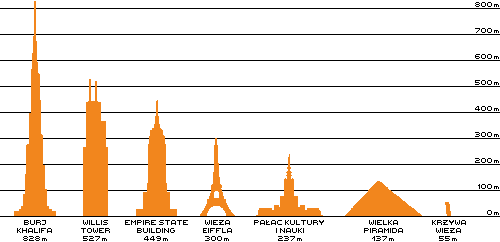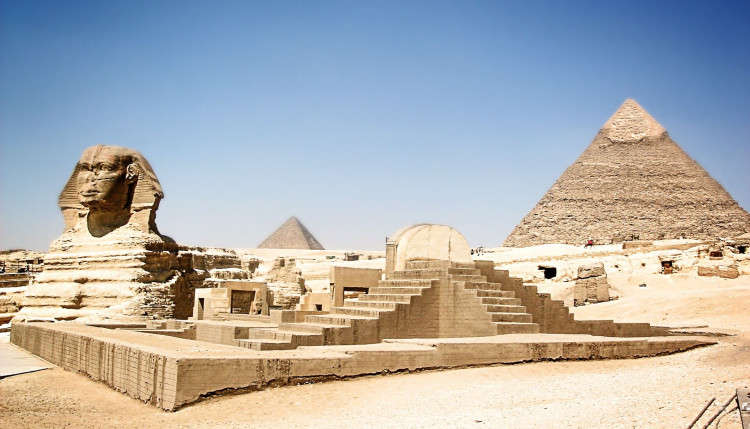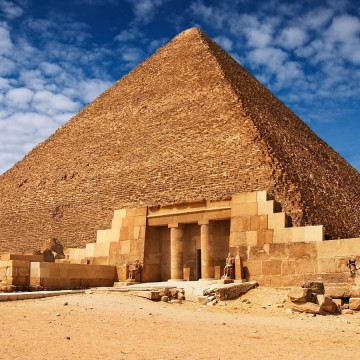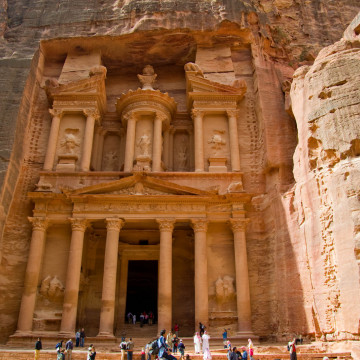Great Sphinx of Giza - 73 meters high monument with lion body and human head
Where is located Great Sphinx of Giza?
Address of Great Sphinx of Giza is Giza, Egypt
show on map
When was built Great Sphinx of Giza?
Built date of Great Sphinx of Giza is Ok. 5000 years ago

Facts, informations and history of Great Sphinx of Giza
This statue has a lion's body and a human head, it is 20 meters high and 73 meters long. At the widest point the face is over 4 meters.
The statue is forged in the monolithic rock remaining after mining the stone at 330 m distant The Great Pyramid, , was built by Pharaoh Chefren (the head of the Sphinx is apparently his portrait).
For centuries, the Sphinx has been a symbol of mystery and mystery. It is presumed that he is the guardian of the pyramids lying behind him.
He has a royal headgear and a royal cobra on his forehead, formerly decorated with a Uraeus and a square beard, probably originally plastered and painted in red.
Sphinx is missing a part of his nose. On this subject arose various guesses, some claim that he lost it due to the influence of sand and winds others, that through numerous earthquakes, still others suspect Napoleon soldiers who allegedly had to organize a shooting competition in the nose of the statue.
In the New State, the Sfinks remained in connection with the cult of the sun and was considered the symbol of Horus (the Egyptian god of the sun).
The building often covered the sand. Until 1926, the Sphinx was buried up to the neck in the sand. It has recently been restored in the 1990s.
Geologist Robert Schoch announced in 1991 a fact that still remains a mystery, namely, he claims that Sfinks has traces of erosion from the water. Only their head does not have them, which additionally certifies the history of its processing.
Inside the building there are three tunnels. Two of them were discovered in 1881, they were opened in 1979. The third tunnel was discovered in 1926 and it has not been opened since then.
"lived in our time a man named Saim al-Dahr, who was a dervish. This man, wanting to heal matters of religion, went to the pyramids and smeared the face of Abdul-Hol (one of the Arabic sphinx expressions), which henceforth remains to this day Since this disfigurement, sand has broken into farmlands in Giza, and people attribute it to Abdul-Hol." - Arabic chronicles of Al-Makrizi
How many meters have Great Sphinx of Giza?
Height of Great Sphinx of Giza is 20 meters


Construction/building type
Building Great Sphinx of Giza is of type Monument, Statue
Architectural style
Architectural style of Great Sphinx of Giza is Ancient Egyptian
Ancient Egyptian architectural style was specific to Egypt between 3150 BC and 395 AD and was uniquely characteristic of the country and its culture. Egyptian architecture was inspired by the landscape and climatic conditions of the region and by the ever-growing needs of the society. ... czytaj więcej.
Other dimensions, parameters and frequently asked questions

How many meters have Great Sphinx of Giza?
Great Sphinx of Giza have length 73 meters
What material is the building made of?
Great Sphinx of Giza is made of the following materials: Monolith
Other names
The building is also known by other common names or in the original language, i.e. Hor-em Archet (egip.)
Is the building on the UNESCO World Heritage List?

The listing took place in the year 1979.
Details of the entry are available on the Unesco website at https://whc.unesco.org/en/list/86/
Photo gallery Add photo
Location on map / How to get there

























Comments to Great Sphinx of Giza (88) Average rating: 5 Add comment / Rate building
Based on 88 comments